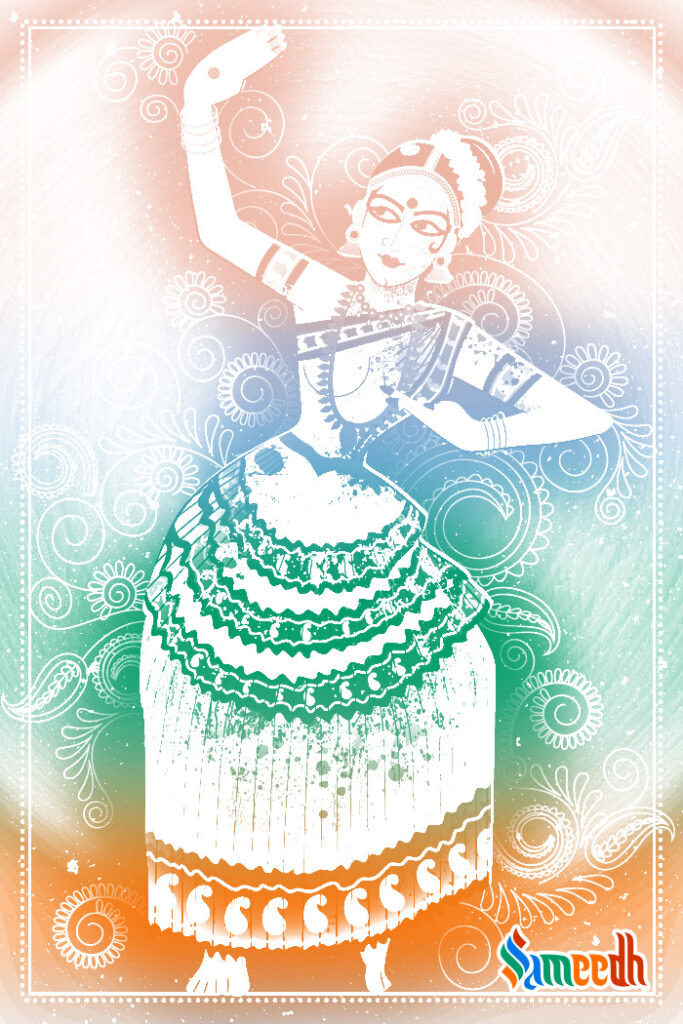Mohiniattam has been mentioned in the Natya Shastra and it takes inspiration from the term ‘Mohini,’ which refers to Lord Vishnu’s female avatar during the Amrut Manthan.

Mohiniattam is an Indian classical dance form that originated in the Indian state of Kerala. It is one of the two most prominent dance forms in Kerala, one of which is Kathakali.
History of Mohiniattam
Unlike other Indian classical dance styles, Mohiniattam belongs to the Lasya type, which displays a more elegant, soft, and feminine way of dancing.’ Mohiniattam has been mentioned in the Natya Shastra and it takes inspiration from the term ‘Mohini,’ which refers to Lord Vishnu’s female avatar.
As per ancient narrative, Bhagwan Vishnu disguised himself as ‘Mohini’ to lure the Asurs during the Amrut Manthan and killing of Bhasmasur. The delicate physical movements and gentle facial expressions have a more feminine feel to them, making them suitable for female performers. Vyavaharamala, authored in 1709 by Mazhamagalam Narayanan Namboodiri, and Ghoshayatra, and written later by renowned poet Kunjan Nambiar, also contain references to Mohiniattam.
Mohiniattam evolved into what we know today as a result of an extended evolutionary process. Its history can be traced back to Kerala’s temples, despite the fact that the exact date of its inception is unknown. There is evidence of a group of female temple dancers who added artistic motions to the mantras repeated by temple priests to enhance temple festivities. The performers were given different names at different points in time. Tai Nangai or Nangachi (one with a lovely hand), Dasi (servant), Tevitichi or Deva-Adi-Achi and Koothachi (one who served God by performing dance) were some of their names (who performed koothu or dance). Their dances were dubbed Nangai Natakam, Dasiyattam, Tevitichiyattam, and other names.
Due to the support of various princely kingdoms, Mohiniattam flourished as a performance art form in the 18th and 19th centuries. The Maharaja of the Kingdom of Travancore, Swathi Thirunal Ram Varma, a poet and excellent music composer himself, initiated and patronized the formation of a joint team of performers from two genres, Bharatanatyam and Mohiniattam, in the early 19th century. His contributions to the art form resulted in the modern-day Mohiniattam being developed and systematized.
Decline of Mohiniattam
When British rule began to spread during the 19th century, different classical dance styles were despised and forbidden, leading in their extinction. Subsequently, the Christian missionaries’ and British authorities’ disgust and vile attitude towards the danseurs, humiliated such systems. Additionally, the Christian missionaries in 1892 started an anti-dance agitation to put an end to the tradition. The facial gestures and voluptuous movements expressed during temple dances were portrayed in Marcus B. Fuller’s book ‘The Wrongs of Indian Womanhood,’ published in 1900. All Indian traditional dance styles were vilified as a result of such turmoil, Mohiniattam and other dance styles of Kerala witnessed a downfall.
Reviving Mohiniattam
Poet Vallathol Narayana Menon reignited awareness in mohiniattam in 1930, by adding it in the schedule of his Kerala Kalamandalam; a facility which fostered the establishment and promotion of Kerala’s ancient traditions.
In the ‘Natya Shastra,’ Mohinattam is divided into two performance categories: Nritta and Nritya. It demonstrates perfection in the ‘Ekaharya Abhinaya’ form and highlights a more elegant, soft, and feminine form of dancing. ‘Nritta’ is a kind of performance wherein the dancer executes only pure dance movements, highlighting movement, style, sequence, flexibility, and rhythmic qualities without enacting or expressing elements. A story and spiritual concepts in ‘Nritya are displayed by the dancers through dramatic expressions and slow physical motions coordinated with music. ‘Natyam’ is performed by trained artists who use dance to narrate a story. Cholkettu, Jatisvaram, Varnam, Padam, Tillana, Shlokam, and Saptam are all part of Mohiniattam’s composition.
